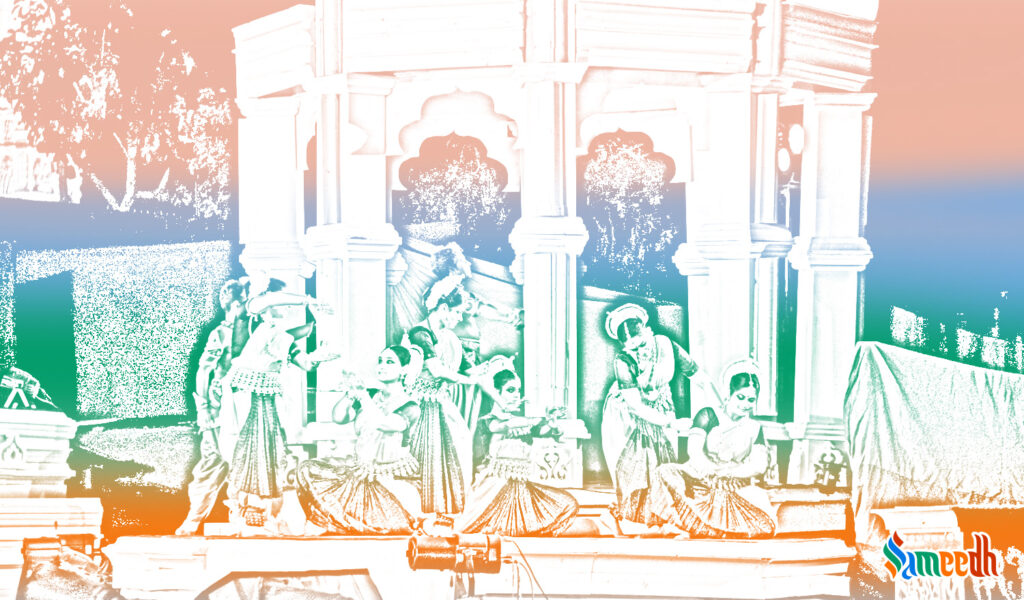Kathak is a northern Indian dance that is frequently associated with love. Both men and women take part in it. The movements involve delicate footwork emphasised by ‘ghungroo’ worn on the ankle and artistic gestures which have evolved from natural body language.

Kathak comes from the term Katha, which refers to a story. The Kathakars, known as storytellers, are artists who tell stories based on epics, tales, and legends. Acting and mannerisms may have been introduced later to improve the recitation’s effect. As a result, a rudimentary form of expressive dance arose; laying the groundwork for what would later become Kathak as we know it today.
The Kathakars traveled around narrating stories with music, dance, and songs. The Bhakti movement, a movement of scriptural devotion that emerged in medieval Hinduism, gave birth to the genre. The Kathakars use synchronized footsteps, hand movements, facial expressions, and eye work to tell stories. In the palaces of North Indian kingdoms, this performing art that mixes legends from old mythology and major Indian epics, particularly from Lord Krishna’s life, became highly famous.
Under the aegis of Wajid Ali Shah, the last Nawab of Awadh, Kathak reached its peak in the eighteenth century. He founded the Lucknow gharana, which emphasises bhava, or the representation of emotions and feelings. Other prominent Kathak dancing schools include the Jaipur gharana, which is famed for its layakari or rhythmic brilliance, and the Benaras gharana. Kathak has its own unique movement technique. The Jaipur gharana, the Benaras gharana, and the Lucknow gharana are three distinct variants of this genre, each with its own focus on dancing and performance.
An elaborate method of footwork is used to construct the technique. Pure dance is significant because it allows the dancer to construct complicated rhythmic patterns by using flat feet and controlling the sound of ankle bells. As with the other traditional dances, pure dance sequences are created by merging movement units. Tukra, tora, and parana are all names for cadences that refer to the nature of the rhythmic sequences and the percussion instrument that supports the dance. The dancer begins with a ‘Thaat’ sequence, which introduces delicate motions of the neck, eyebrows, and wrists. This is then followed by a formal entrance referred as the Amad and the salutation known as Salami.
Kathak has evolved into three distinct forms over time: Classical, Contemporary, and Sufi. With its rapid twirls, distinctive rhythmic virtuosity, and poetic expression of passionate and spiritual poetry, it fascinates and enthralls viewers. Crisp yet smooth maneuvers, combined with precise and quick rotations, create a visual feast on-stage, immersing viewers in a transcendental experience. Kathak’s resemblances can be found in various dance genres that have their origins in other nations. For example, Flamenco (Spain) , Raqs Sharqi (Egypt), Ballet (Russia, France, and Italy), Tap dance (Ireland), and Belly dancing (Middle East) have a close connection with Kathak.
Pandit Birju Maharaj, a descendent of the legendary Maharaj family as well as son of Acchan Maharaj, is a name that has nearly become synonymous with modern-day Kathak dancing. He is regarded as the foremost promoter of the Lucknow Kalka-Bindadin gharana. Sitara Devi was another icon of this dance form, characterised by Rabindranath Tagore as Nritya Samragini, the empress of dance, and she has retained her Kathak Queen title long after her death. Roshan Kumari, Shovana Narayan, Maya Rao, and Kumudini Lakhia, to name a few, are some well-known Kathak artists. The founders of the many gharanas or schools of Kathak include Bhanuji of the Jaipur Gharana, Raja Chakradhar Singh of the Raigarh Gharana, Janaki Prasad of the Benaras Gharana and Ishwari Prasad of the Lucknow Gharana. Shambhu Maharaj was a well-known Lucknow Gharana guru. Lachhu Maharaj and Acchan Maharaj, two of his brothers, were also Kathak legends.
